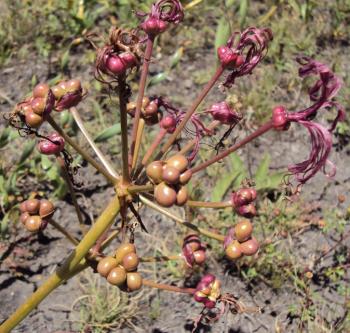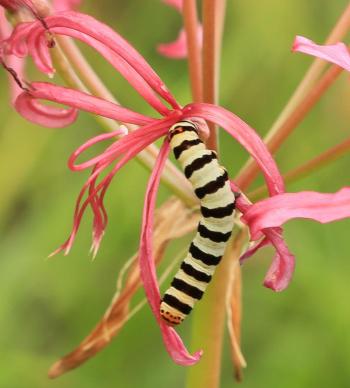Nerine krigei
Nerine krigei W.F.Barker
Family: Amaryllidaceae
Common names: corkskrew nerine, curly leaved nerine (Eng.); draaiblaar nerine (Afr.)
Introduction
A marvellous bulbous plant that is characterized by distinctive erect, spirally twisted leaves.

Description
Description
Nerine krigei is a summer-growing, bulbous plant, 300–600 mm tall; the bulb produces a neck up to 40 mm long. This plant has broad, green leaves, up to 270 mm long and 12 mm wide. Flowers are pale pink and borne in a large, terminal, umbellate inflorescence. The flowers have dark green-rose midribs which show up nicely against the dark pink petals. Filaments recurve 180º. Flowers are produced in late summer (January–March).

Most nerines produce many offsets from the bulb, however, they do not all flower every year. N. krigei produces many offsets and flowers faithfully every season, although it does require a period of chilling during the preceding winter. The bulbs reach flowering size when about 30 to 40 mm in diameter. If undisturbed, a plant will persist and flower for many years.
Conservation Status
Status
Nerine krigei is not threatened, and is assessed as least concern (LC), according to the Red List South African Plants.
Distribution and habitat
Distribution description
Nerine krigei is endemic to South Africa and is found in the Gauteng and Mpumalanga Provinces, growing in damp depressions in grassland.

Derivation of name and historical aspects
History
Rev. William Herbert established the genus Nerine in 1820. It is named after Nerine, a guardian sea nymph sent by Roman goddess Venus to rescue Vasco da Gama's armada en route to India. Nerine krigei is named in commemoration of Mr J.D Krige of Stellenbosch, who first found this species, in the southeastern areas of Johannesburg, in the early 1930s.
Nerine is a genus of 24 species in the family Amaryllidaceae, 20 of which are endemic to the geographic areas of South Africa, Lesotho and Swaziland.
Ecology
Ecology
Nerine krigei may attract wildlife to the garden, such as butterflies and other insects, which pollinate the flowers.
Seeds are fleshy and fall to the ground when ripe and germinate almost immediately, forming a leaf and a small bulb before the onset of winter.

Uses
Use
The bulbs of Nerine contain poisonous alkaloids, but do not normally cause death if eaten.
Growing Nerine krigei
Grow
All Nerine species can be successfully cultivated in containers. N. krigei is well suited to rockery pockets, whereas finer dwarf species, are best grown in pots. For best effect, Nerine krigei must be planted in groups, or else scatter them amongst wetland grass to obtain pink splashes in summer.
Nerine krigei is an easily grown species that will grow and flower well in most free-draining garden soils to which organic matter, such as well decomposed compost, has been added. A suggested mixture when growing Nerine in containers, is equal parts of river sand, silica sand and finely sifted compost. Bulbs of N. krigei should be planted with the comparatively long neck fully covered with soil, in order for the top of the neck to rest just below the surface.
As the bulbs have fleshy roots which resent disturbance after planting, they should be left in the same position for many years, until they eventually become too overcrowded and may need to be lifted and divided. Mature bulbs freely produce offsets and propagate easily from seed. They may reach flowering size within 3 to 4 years. Seeds can be sown in deep seed trays in a well-drained seedling mixture, such as equal parts river sand, silica sand and finely sifted compost. Spread the seeds evenly, press them lightly into the mixture and cover with a thin layer of the same mixture, and water well.

N. krigei plants are susceptible to mealy bug and lily borer, where the tiny caterpillars can bore into leaf, stem or flowering tissue; they may eventually bore into and consume the bulb itself, causing the collapse and death of the whole plant. If left unattended slugs and snails can also cause damage to the plant and may transmit viral diseases.
A full sun position is recommended and regular deep watering during the summer growing period, is required. It is recommended that bulbs should be kept dry during the winter dormant period; this hardy species can withstand cold and frost in winter, but require sufficient moisture during summer for it to flower freely.
References
- Duncan, G.D. 2002. Grow nerines: Kirstenbosch Gardening Series. National Botanical Institute, Cape Town.
- Duncan, G.D. 2016. The Amaryllidaceae of southern Africa. Umdaus Press, Pretoria.
- Du Plessis, N. & Duncan, G. 1989. Bulbous plants of southern Africa, a guide to their cultivation and propagation. Tafelberg, Cape Town.
- Snijman, D.A. & Victor, J.E. 2004. Nerine krigei W.F.Barker. National Assessment: Red List of South African plants version 2015.1. Accessed on 2017/01/16.
- iSpot southern Africa: http://www.ispotnature.org/species-dictionaries/sanbi/Nerine%20krigei?nav=search
Credits
Thato Moeketsane and Lungisani Zondi
Walter Sisulu National Botanical Garden
February 2017
Images courtesy of Georg Fritz and Clinton Rautenbach
Plant Attributes:
Plant Type: Bulb
SA Distribution: Gauteng, Mpumalanga
Soil type: Sandy, Loam
Flowering season: Late Summer
PH: Acid, Neutral
Flower colour: Pink
Aspect: Full Sun
Gardening skill: Easy
Special Features:
Horticultural zones









Rate this article
Article well written and informative
Rate this plant
Is this an interesting plant?
Login to add your Comment
Back to topNot registered yet? Click here to register.